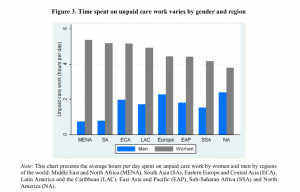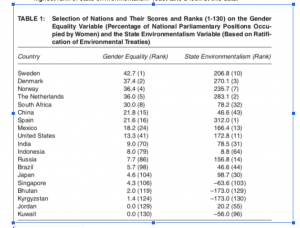This just in: women have the power to defeat climate change. Yup, we’re the world’s secret weapon. The involvement of women in environmentalism is crucial and experts are proving that. Cold, hard facts, people! Here is a breakdown of what I’m talking about.
Norgaard & York start out by making these opening points:
In an unequal society:
- impacts of environmental degradation are experienced the most by the least powerful (gendered divisions of land, labor affect women specifically)
- Women have greater experience with environmental problems because of this – as per Wangari, Thomas-Slayter, and Rocheleau 1996.
- Women have societal roles as caretakers…
- Changes in the economic structure of production such as increase in cash crops, and decrease of subsistence crops led to benefits for men and a heavier workload for women
To summarize the other main points of the study, take a look:
- A generation of feminist theorists argue that the state is both capitalist, patrirchial, and created as a ‘gendered process’ – as per Cravey (1998)
- ***Studies of gender/environmental/ecofeminism show how nations with greater gender equality may have a better chance of protecting the environment
- Research shows that women are “more likely than men to show support for environmental protection and that women consider a variety of environmental risks, from nuclear power to toxic substances, to be more serious than do men” – as per Bord and O’Connor 1997, and Davidson and Freudenburg 1996 (Norgaard, York 508).
- The oppression of both women AND nature are closely linked, as also shown in expert research because they are both related to a hierarchical social structure that degrades nature and women at the same time, “the values, ideologies, institutions, and economic systems that shape human-environmental relationships are them- selves gendered… these factors enable sexism and environmental degradation in mutually reinforcing ways” (Norgaard, York 508).
- If women participate in society as parts of the government / have greater political power, the nations in which this happens will be more inclined toward supporting environmental protection, “these reasons include the fact that women have more pro-environmental values, are more risk averse, are more likely to participate in social movements, typically suffer dis- proportionately from environmental degradation, and sexism and environmental degradation can be mutually reinforcing processes” (Norgaard 519). In other words, women are more likely to get involved in environmental preservation causes.
- Norgaard concludes with stating that “global efforts aimed at developing environmental policies should therefore concentrate more on improving the status of women” (Norgaard, York 519) – especially the political presence of women. Which is demonstrated on page 512 of the article in Table 1.
- Table 1 shows that nations with the highest rank of gender equality also have the highest rank of state environmentalism – Just take a look at this data:

(Norgaard,York 512)
2 examples which illustrate Norgaard and York’s thesis are this blogpost by Yao Bogoma from the African Wildlife Foundation, and a study done by P. Mago and Isha Gunwal about the role of women in environmental conservation.
Bogoma opens his blogpost by making a point very similar to the main idea in the Norgaard/York study, “In some countries around the world, women are still not equal to men in law. Yet, within these same countries, the very building blocks of society are driven by the immense amount of work done by women.” He then goes on to explain how women are truly owed the credit of the survival of African communities – especially during times of struggle because of all of the labor women hold as responsibilities. This includes firewood gathering, tending to the fields, and getting meat for the family to eat. The rest of the post focuses on the negative effects that poverty has on African women, and Bogoma describes the story of a woman, Pauline, who even violated the law in attempts to provide a living for her children by trading meat of endangered animals during the Ebola crisis. However, Pauline overcomes this and eventually becomes an advocate for alternative livelihood projects, which implement activities within a community such as fish-pig poultry farming, tending to livestock and crops, microcredit, and professional training in sewing and tailoring. This is just one of many stories of women taking part in the positive transformation of the ecological world.
In this study titled, “Role of Women in Environment Conservation”, authors P. Mago and Isha Gunwal go into depth about the roles of women in different places around the world, specifically India, when it comes to the environment and conserving natural resources. In the abstract, there is one statement that is reminiscent of Norgaard & York’s main thesis, “ Before the 18th and 19th century, it was considered that women had no role in environmental conservation and promotion, as well as they were avoided in all major spheres of social life. But after spreading awareness about their rights and duties, and taking cognizance of their surroundings, they consciously tried to raise voice against environment degradation” (Mago, Gunwal). They then go on to describe women’s roles as supervisors of natural resources such as water, sources of fuel, food, forests, and crops in places like India and Africa, highlighting the importance of women’s participation in environmentalism. It seems that the major theme here is that women are crucial to daily life and survival in these communities. This reminds me of York and Norgaard’s thesis because of the discussion of women’s increased involvement in ecological matters and that involvement’s effect on environmental conservation.
As for a different statistic that illustrates Norgaard and York’s central thesis, I think this one works pretty well:

This image comes from a study titled, “Policy Coherence for Sustainable Development and Gender Equality” done by the OECD (Organisation for Economic Co-operation and Development). I think this chart shows that women are likely to be involved in activist matters, more so than men because the data shows that there is a staggering difference in men and women when it comes to unpaid care work… and most of the time, environmentalist work is unpaid.
Works Cited
Bongoma, Yao. “African Wildlife Foundation.” African Wildlife Foundation, African Wildlife Foundation, 8 June 2015, https://www.awf.org/credits-and-copyright.
Norgaard, Kari, and Richard York. “Gender Equality and State Environmentalism.” Gender & Society, vol. 19, no. 4, 2005, pp. 506–522., doi:10.1177/0891243204273612.
Mago, P, and Isha Gunwald. “Papers.ssrn.com.” Papers.ssrn.com, SSRN, 7 May 2019, papers.ssrn.com/sol3/papers.cfm?abstract_id=3368066.
Annotated Source
Boarini, Romina, et al. “Oecd.org .” Oecd.org , OECD, www.oecd.org/gov/gender-mainstreaming/policy-coherence-for-sustainable-development-and-gender-equality.pdf.
This source provided a graph for me to use in my blogpost about the amount of women who take on unpaid care work as opposed to men. The data from this graph helped further prove a main point of Norgaard and York’s findings / thesis that women are more likely to participate in environmental activism.


